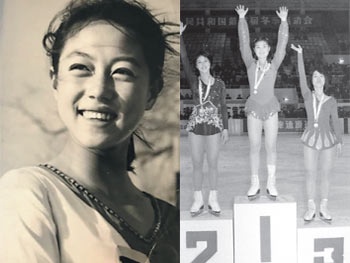Olympic pioneer Bao Zhenhua looks back fondly on her momentous career

Like many other Chinese born in the 1960s, Bao Zhenhua's given name was imbued with the cultural significance of the time - literally meaning "to revitalize China".
As a 14-year-old figure skater who witnessed China's debut at the Winter Olympics, her name turned out to be extra appropriate.
Whole new world
In February 1980, Bao was part of the Chinese delegation sent to participate in the 13th Winter Olympic Games in Lake Placid, New York.
She was not regarded as the country's best skater, but her youth and shining smile seemed to make her a fitting representative of a changing China just two years into its opening-up.
It proved something of an overwhelming experience for the teenager.
"Everything happened all of a sudden," said Bao.
"Heading to the Olympics sounded so sweet to me. I don't know how to describe my feelings - nervous, excited, curious and overcautious - it was so complicated."
Bao recalled with a laugh how she almost forgot her moves after seeing her foreign rivals train.
"My mind was blown. They were so good and I never saw those moves before," she said.
"Disco music was very popular around the world in the 1980s and I was stirred to see the foreign athletes dance to the rhythm."
Bao was memorably interviewed by legendary American skater Peggy Gail Fleming, the 1968 Olympic singles champion, for US television.
"Peggy was the commentator with ABC. She asked me what I would do after the Olympics and I said I'd definitely skate all my life," said Bao, who ultimately finished last in the singles competition.
Humble beginnings
Born into a skiing family in northeast China's Jilin province, Bao grew up surrounded by winter sports. But as a young girl, she couldn't tell the difference between figure skates and speed skates.
"I just knew I needed to learn dancing in figure skating and girls always love beautiful things, so I just wore figure skates," she said.
"There weren't any big brands to choose from. The skates were handmade by my coach, who also took to mending them - they were easy to break on outdoor rinks."
In the late 1970s there were no indoor rinks in China, so training was limited to the winter month.
"We poured water onto the playground at school, and that was the rink when the water froze. You can imagine how rough the ice was," said Bao, who also remembers how the cold made training a real hardship.
"The pictures from the 1970s look funny nowadays. We wore too much to perform our moves properly, but we felt so cold if we didn't wear enough.
"We could hardly even unbuckle our pants in the toilet as our hands were so numb."
A pre-Games training camp in Japan was Bao's first experience of skating indoors.
Like her footwear, her first skating dress was handmade by her coach, Miao Ruifu, using dacron, an elastic material unsuitable for jumping, spinning and splitting.
For Bao's Olympic performances, Miao had a nylon dress specially made by a textiles mill. The multi-tasking coach was also responsible for choreography, music and organizing the skaters' daily lives.
Tough times
After Lake Placid, Bao set her sights on making the next Olympics, training in the US and Germany before an injury setback just before the 1982 world junior championships.
"Those four years were the most difficult period of my life,... and the most frustrating period as well," she recalled.
"Me and my coach, we worked so hard to get better results."
Like most athletes, her biggest opponent was her own body. She began to challenge herself to complete more difficult jumps and spins without any protective measures.
Hundreds of tumbles, however, could not deter Bao from her Olympic dream.
At the 1984 Games in Sarajevo, Yugoslavia, she fell and finished 19th. Heartbroken by the result, Bao decided to retire.
Skating might not have brought her medals, but it did bring her a lifelong partner in Bian Shaotang, who was captain of China's men's hockey team.
The pair married after retiring from national duty, but winter sports have remained constant in their lives.
Back home
The couple moved to Japan to pursue college educations in the 1990s but have always kept an eye on the fortunes of Chinese figure skaters.
Bao and her family drove some 10 hours from Kyushu to Nagano to cheer for eventual bronze medalist and fellow Jilin native Chen Lu at the 1998 Winter Olympics. And while she had to settle for watching from the couch, Bao found Shen Xue and Zhao Hongbo's pairs gold at the 2010 Vancouver Games particularly rousing.
"That was another historic moment for Chinese figure skating," she said. "We'd been waiting 30 years for that!"
With Beijing and Zhangjiakou hosting the 2022 Games, indoor rinks are popping up all over China - even in the warmer southern regions.
The skating boom has created a demand for coaches, so Bao and Bian have returned to their homeland to lend their expertise.
For the past year, Bao has been coaching kids at a training agency in southeastern city Fuzhou, which opened its first two indoor rinks in 2016 in a shopping center.
"Skating is a special experience for the southerners. Many people come to try and learn during weekends and holidays," said Bao.
"Sometimes there are too many skaters and the rink seems too small and the number of skates for rent is far from enough."
Still, those Fuzhou folk just might have some untapped talent.
"The southerners, generally speaking, are not as tall and strong as the northerners, but they can be more skilful," said Bao.
"Maybe it's a kind of advantage in figure skating that we had not seen before."



